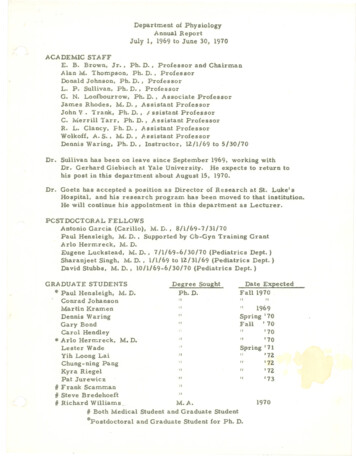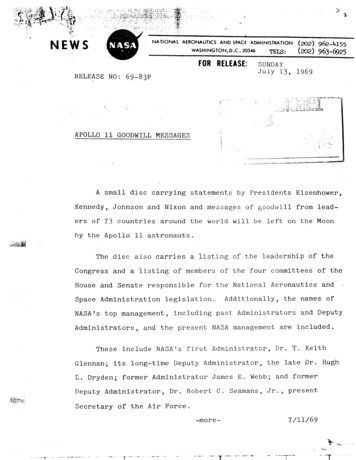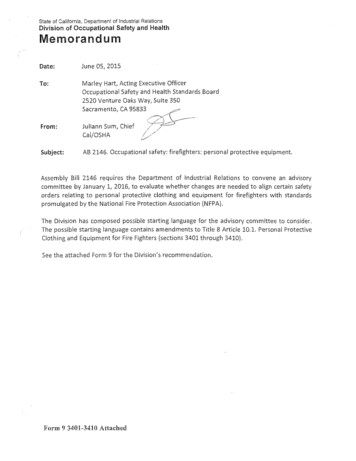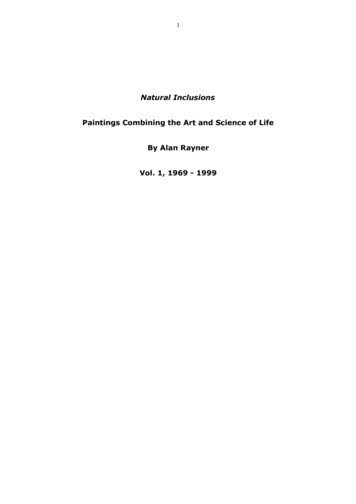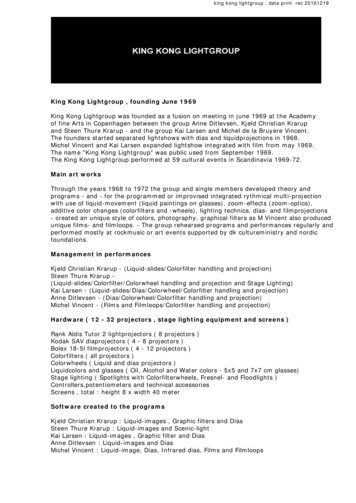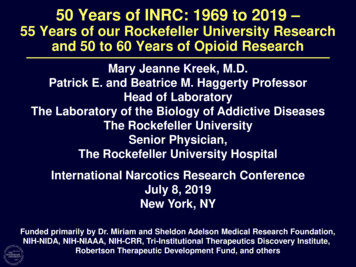
Transcription
50 Years of INRC: 1969 to 2019 –55 Years of our Rockefeller University Researchand 50 to 60 Years of Opioid ResearchMary Jeanne Kreek, M.D.Patrick E. and Beatrice M. Haggerty ProfessorHead of LaboratoryThe Laboratory of the Biology of Addictive DiseasesThe Rockefeller UniversitySenior Physician,The Rockefeller University HospitalInternational Narcotics Research ConferenceJuly 8, 2019New York, NYFunded primarily by Dr. Miriam and Sheldon Adelson Medical Research Foundation,NIH-NIDA, NIH-NIAAA, NIH-CRR, Tri-Institutional Therapeutics Discovery Institute,Robertson Therapeutic Development Fund, and others
International Narcotics Research ConferenceFounders Lecturers(First Awardee 1999)1999200020012002200320042005200620072008Eric J. SimonBrian M. CoxPhilip S. PortogheseLars TereniusBernard RoquesJi-Sheng HanMary Jeanne KreekHuda AkilStan WatsonVolker HoelltHorace LohJan van Ree20092010201120122013201420152016201720182019R. Alan NorthMasamichi SatohCharles ChavkinF. Ivy CarrollGraeme HendersonChristopher EvansBrigitte KiefferGavril Pasternak (d. 2019)Lakshmi DeviJohn TraynorMacdonald ChristieSol SnyderKreek 2019
International Narcotics Research ConferenceFounders Lecturersat this 50th Anniversary c J. SimonBrian M. CoxPhilip S. PortogheseLars TereniusBernard RoquesJi-Sheng HanMary Jeanne KreekHuda AkilStan WatsonVolker HoelltHorace LohJan van Ree20092010201120122013201420152016201720182019R. Alan NorthMasamichi SatohCharles ChavkinF. Ivy CarrollGraeme HendersonChristopher EvansBrigitte KiefferGavril Pasternak (d. 2019)Lakshmi DeviJohn TraynorMacdonald ChristieSol SnyderKreek 2019
Ji-Sheng Han cannot attend this 50th Anniversary meeting because of a familyillness and sends his regards, along with this photo of him with his family.Ivy Carroll and Bernard Roques are unable to attend this year because of illness.Brigitte Kieffer and Huda Akil could not attend because of university business.All send their regards!Kreek 2019
Early Opioid Research ofMartin (US) and Collier (UK) – 1961Hypothesis and experimental evidence of the development oftolerance to and dependence on opiates with chronic exposure(heroin, morphine, methadone, other)Martin, W.R., Frasier, H.F. A comparative study of physiological and subjective effectsof heroin and morphine administered intravenously in postaddicts. JPET, 133:388-99.(1961)Collier, H.O., Warner, B.T., Skerry, R. Multiple toe-pinch method for testing analgesicdrugs. Br J Pharmacol Chemother. 17:28-40. (1961) (in rodents)Frasier, H.F., Van Horn, G.D., Martin, W.R., Wolbach, A.B., Isbell, H. Methods forevaluating addiction liability. (A) “Attitude” of opiate addicts toward opiate-like drugs.(B) a short-term “direct” addiction test. JPET, 133:371-87. (1961)Martin, W.R., Eades, C.G. Demonstration of tolerance and physical dependence in thedog following short-term infusion of morphine. JPET, 133:262-70. (1961)Kreek 2019
55th Anniversary of the Beginning of Our RockefellerInstitute (now University) Research: 1963-1964Treatment of Heroin Addiction: Identification of Need, Formulation ofHypothesis, Basic Clinical and Related Laboratory Research,Translational Research, and EvaluationsAutumn1963Vincent P. Dole, Jr., MD recruitment of two new staffmembers to his Laboratory of Physiology andMetabolism at The Rockefeller Institute for MedicalResearch:1) Marie Nyswander, MD – psychiatrist, years ofwork with heroin addicts in New York City andLexington, KY. Author of book The Addict as aPatient.2) Mary Jeanne Kreek, MD – second year Residentin (Internal) Medicine (“PGY-2”) at Cornell-NewYork Hospital with experience in clinical andlaboratory based research at NIH and ColumbiaP&S.January – New team formed and first patients admitted to theJuly 1964 Rockefeller Hospital; initial research on potentialnovel pharmacological treatment of heroinKreek 2019addiction, accomplished by July 1964.
Development of Methadone MaintenanceTreatment – 1964-19661964 HYPOTHESIS –NOWEVIDENCE-BASED FACT:Heroin (opiate) addiction is adisease – a “metabolic disease” –of the brain with resultantbehaviors of “drug hunger” anddrug self-administration, despitenegative consequences to self and others. Heroin addiction is notsimply a criminal behavior or due alone to antisocial personality orsome other personality disorder.First publications describing methadone maintenance treatment research1) 1964: Initial clinical research on development of treatment using methadonemaintenance pharmacotherapy and on elucidating mechanisms of efficacy performedat The Rockefeller Hospital of The Rockefeller Institute for Medical Research:Dole, V.P., Nyswander, M.E. and Kreek, M.J.: Narcotic blockade. Arch. Intern.Med., 118:304-309, 1966.(also recorded in the Association of American Physicians meeting transcription of discussion)2) 1965: Translational applied clinical research performed at Manhattan General Hospital:Dole, V.P. and Nyswander, M.E.: A medical treatment for diacetylmorphine(heroin) addiction. JAMA, 193:646-650, 1965.Kreek 2019
Impact of Short-Acting Heroin versus Long-ActingMethadone Administered on a Chronic Basis in Humans(1964 through 1973 Studies): Opioid AgonistPharmacokinetics – Heroin Versus MethadoneFunctional State(Heroin)“On-Off”"High""Straight"Drug orMedicationApparent Plasma TerminalHalf-life and Duration ofDesired EffectsHEROIN3 min for prodrug30 min for activecompound, mono-acetylmorphine (fast on-set andoff-set)"Sick"AMPMAMPMAMDaysFunctional State(Methadone)“Steady State”6 hours for activemetabolites (morphineand MAM24h for racemic (rs)medication (slow on-setand off-set – steady-stateachieved)48h for active (r)enantiomerDole, Nyswander and Kreek, 1966; Kreek et al., 1973; 2019
1973Kreek, New York State Journal of Medicine, Vol. 73, No. 23, December 1, 1973
“On-Off” versus “Steady-State”:Relationship Between Blood (and Brain) Levels ofDrugs of Abuse and Their EffectsDisruption versus Normalization levels of gene expression receptor mediated events physiology behaviorsRates of rise of blood (and presumable brain) levels of drugsof abuse are related positively to their reinforcing effectsRates of fall of blood (and presumably brain) levels of drugsof abuse are related positively to the onset of withdrawalsymptoms and/or acute “craving”Kreek, 1973 on, 2019
1965-1968: Early Expansion ofMethadone Maintenance Treatment1964-1967 – Initially all patients admitted as active or recently abstinentheroin addicts to the Rockefeller Hospital, unlocked research ward forinpatient induction into methadone maintenance treatment (minimum 68 weeks). Follow-up in Rockefeller Hospital Outpatient Department.1965-1966 – Replication of methadone maintenance treatment researchmodel in an inpatient unit of the Manhattan General Hospital, a fee-forservice proprietary hospital (later to become the Bernstein Institute ofBeth Israel Hospital), which had been engaged in 10-14 daydetoxification “treatment” for opiates (“revolving door”).1967-1968 – Introduction of outpatient induction into methadonemaintenance treatment (at the Rockefeller Hospital clinic, Dr. MJ Kreek).Kreek 2019
Prospective studies of first 214 patients admitted to methadonemaintenance research and treatment (January 1964 – July 1966,and followed-up for three years or more) and RetrospectiveStudy of 1435 methadone maintenance patients.1973
1967-1973: Further Expansion ofMethadone Maintenance Treatmentand FDA Approval1967-1972 – Development of multiple satellite outpatient methadonemaintenance treatment programs at Harlem, Beth Israel, St. Luke’s,Roosevelt, and Einstein Hospitals in New York City (Dole, Nyswander,Kreek, Lowinson, et al.).1967-1972 – First replication of methadone maintenance program outsideof New York City – Department of Psychiatry, University of Uppsala,Uppsala, Sweden (Dr. Lars Gunne and later Drs. Leif Grönbladh and OlofBlix).1969-1973 – Opening of the “Adolescent Development Program” (selfadministration for three years in age 15-21) (Elizabeth Khuri and RobertMillman) and “Adult Program” (Aaron Wells) at New York HospitalCornell Medical Center.1973 – Approval by US-FDA of long-term moderate to high dosemethadone maintenance treatment for opiate addiction.Kreek 2019
Synthesis and Early Studies of Mu Opioid ReceptorAntagonists Naloxone, and Subsequently Naltrexone andNalmefene: Use in Reversal of Opiate Overdose andLater Treatment of Addictive Diseases (1967 onward)In 1967, Dr. Jack Fishman, a chemist and endocrinologist working with severalinstitutions in New York City, visited with one of his former medical students(MJK) for lunch at The Rockefeller University. At that lunch, he shared that hehad synthesized a new compound hoping that it would be a “non-addicting painmedication,” but in fact it did not relieve pain, instead it reversed the effect ofshort-acting opiate agonists such as heroin and morphine.“Would there be a clinical use for such a compound?” (JF)That compound was naloxone (Narcan ), which is now used world over for thereversal of opiate overdose, as well as planned narcotic effects during surgeryand related procedures.Dr. Fishman also synthesized and assisted in the development of nalmefeneand naltrexone. Naltrexone was studied and subsequently FDA approved fortreatment of opiate addiction and, later, alcoholism. Nalmefene was studied andsubsequently FDA approved for perioperative effects of opiates and, in Europe,for the treatment of alcoholism. He later became a Professor at The RockefellerUniversity before pursuing drug development in the pharmaceutical industry.He died in 2013.Kreek 2019
International Narcotics Research ConferenceMeeting Sites, Presidents,and Local Chairs – 1969-1979Dates Venue1969 Basel, 9NO MEETINGAberdeen, ScotlandSan Francisco, CA, USAChapel Hill, NC, USACocoyoc, MexicoAirlie House, VA, USAAberdeen, Scotland (#1 mjk)Brewster Academy, NH, USA(Gordon Conference)Noordwijkerhout,Netherlands(mjk missed; birth of EAKS)N. Falmouth, MA, USALocal and ProgramINRC PresidentChairperson(s)H. Collier,H. Collier (d 1983),H. KosterlitzH.Kosterlitz (d 1996)H. KosterlitzA. GoldsteinA. GoldsteinA. GoldsteinA. GoldsteinH. KosterlitzE. SimonH. KosterlitzA. Goldstein (d 2012)A. GoldsteinA. GoldsteinA. GoldsteinS. Archer (d 1996)S. ArcherJ. Van Ree,L. TereniusS. ArcherE.L. Way (d 2017)S. ArcherKreek 2019
Harry CollierAvram GoldsteinHanz KosterlitzSydney ArcherEddie Way
Major Scientific Discoveries or Advances Concerningthe Endogenous Opioid System or the Treatment ofOpioid Addiction – 1969-1979:Unsuccessful Attempts to Delineate Opiate Receptors1970-1971***Hypotheses and attempts to delineate selective endogenous opioidreceptors using the technique of stereo-selective bindingIngoglia, N. A., & Dole, V. P. Localization of d- and l-methadone afterintreventricular injection into rat brains. JPET, 175(1), 84-87. (1970)Goldstein, A., Lowney, L. I., & Pal, B. K. Stereospecific and nonspecificinteractions of the morphine congener levorphanol in sebcellelar fractionsof mouse brain. PNAS, 68(8), 1742-1747. (1971)Kreek 2019
Major Scientific Discoveries or AdvancesConcerning the Endogenous Opioid System orthe Treatment of Opioid Addiction – 1969-1979:Delineation of Specific Opiate Receptors1973***Clear delineation of the existence of endogenous opioidreceptors, successfully using stereo-selective binding of anopioid agonist or opioid antagonistPert, C. B., & Snyder, S. H. Opiate receptor: demonstration in nervoustissue. Science, 179(4077), 1011-1014. (1973)Terenius, L. Stereospecific interaction between narcotic analgesicsand a synaptic plasma membrane fraction of rat cerebral cortex. Actapharmacol toxicol, 32, 317-320. (1973)Simon, E. J., Hiller, J. M., & Edelman, I. Stereospecific binding of thepotent narcotic analgesic [3H] etorphine to rat-brain homogenate.PNAS, 70(7), 1947-1949. (1973)
Development and Discontinuation of a SecondEffective Pharmacotherapy for Opiate Addiction –LAAM (1970-2003)1970-1971Initial development of l-alpha-acetylmethadol (LAAM) for thetreatment of opiate addictionJaffe, J. H., Schuster, C. R., Smith, B. B., & Blachley, P. H. Comparison ofacetylmethadol and methadone in the treatment of long-term heroinusers: A pilot study. Jama, 211(11), 1834-1836. (1970)Jaffe, J. H., & Senay, E. C. Methadone and l-methadyl acetate: Use inmanagement of narcotics addicts. Jama, 216(8), 1303-1305. (1971)1993LAAM approved by FDA for treatment of opiate addiction2002Borg, L., Ho, A., Wells, A., Joseph, H., Appel, P., Moody, D., and Kreek, M.J.The use of levo-alpha-acetylmethadol (LAAM) in methadone patients whohave not achieved heroin abstinence. J. Addict. Dis. 21:13-22. (2002)2003Availability of LAAM discontinued in USAKreek 2019
Major Scientific Discoveries or AdvancesConcerning the Endogenous Opioid System orthe Treatment of Opioid Addiction – 1969-19791975***First elucidation of endogenous opioid peptides: delta-opioid receptor-directed enkephalinsHughes, J., Smith, T. W., Kosterlitz, H. W., Fothergill, L. A., Morgan,B. A., & Morris, H. R. Identification of two related pentapeptidesfrom the brain with potent opiate agonist activity. Nature, 258(5536),577. (1975) mu opioid receptor directed endorphin; POMC, containingbeta-endorphin,as well as ACTH and other importantneuropeptidesTerenius, L., & Wahlström, A. Search for an endogenous ligand forthe opiate receptor. Acta Physiologica Scandinavica, 94(1), 74-81.(1975)1979*** kappa opioid receptor directed dynorphinsGoldstein, A., Tachibana, S., Lowney, L. I., Hunkapiller, M., &Hood, L. Dynorphin-(1-13), an extraordinarily potent opioid peptide.PNAS, 76(12), 6666-6670. (1979)
Development of Novel Techniques and Studies ofthe Pharmacokinetics and Pharmacodynamics ofMethadone – 1976-19811977-1979Techniques developed to measure stereo-selective pharmacokineticsof dl(sr) methadone using gas liquid chromatography in conjunctionwith mass spectrometry utilizing stable isotope technologyHachey, D. L., Kreek, M. J., & Mattson, D. H. Quantitative analysis ofmethadone in biological fluids using deuterium-labeled methadone and GLCchemicalionization mass spectrometry. J Pharm Sci, 66(11), 1579-1582. (1977)Kreek, M. J., Hachey, D. L., & Klein, P. D. Stereoselective disposition ofmethadone in man. Life Sci, 24(10), 925-932. (1979)1976-1981Identification of interactions of other drugs with methadone as usedin chronic maintenance treatment of addiction in humansKreek, M.J., Garfield, J.W., Gutjahr, C.L. and Giusti, L.M.: Rifampin-inducedmethadone withdrawal. N. Engl. J. Med., 294:1104-1106. (1976)Tong, T.G., Benowitz, N.L. and Kreek, M.J.: Methadone-disulfiram interactionduring methadone maintenance. J. Clin. Pharmacol., 20:506-513 (1980)Tong, T.G., Pond, S.M., Kreek, M.J., Jaffery, N.F. and Benowitz, N.L.: Phenytoin-induced methadone withdrawal. Ann. Intern. Med., 94:349-351 (1981)
Opiate (Opioid) Analgesic Agents(1975 onward) Numerous – all mu opioid receptor-directed Diverse formulations – many long-acting (but also some still friable) Most available in oral, sublingual, or patch preparationsExamples – mostly short-actingSustained ., OxyContin )Hydromorphone(e.g., HydromorphoneContin )**OxymorphoneHydrocodone and Acetaminophen(e.g., Vicodin )Meperidine(e.g., Demerol )Fentanyl(e.g., Duragesic )Methadone* (long-acting)(e.g., Dolophine ) – full mu agonistBuprenorphine* (long-acting)(e.g., Subutex sl) – partial mu agonistBuprenorphine-Naloxone* (long-acting)(e.g., Suboxone sl) – partial mu agonist** Removed from market by FDA shortly after approvalKreek, 1975 on, 2019
Use of Methadone as an Analgesic:Doses Usually Range from 0.5mg tid to10mg tid (rarely over 60 mg/d) Very few indications for use of methadone inmanagement of acute pain – because of long-actingpharmacokinetic properties, accumulation ofmedication must be anticipated over the first fourdays or longer. Accidental overdose deaths frequentlyoccur when methadone is so prescribed. Methadone is a superb (and often superior) opioidanalgesic for chronic pain, including neoplastic andnon-neoplastic pain – because tolerance developsmore slowly than to other opioid analgesics, steadydoses may be used over long periods of time andescalation of dose may be gradual; no drowsiness,no dulled responses.Kreek, 1975 on; 2019
International Narcotics Research ConferenceMeeting Sites, Presidents,and Local Chairs – 1980-1989Dates VenueLocal and ProgramChairperson(s)INRC President1980Plymouth State College, E. SimonNH, USA (GordonConference)E. Simon1981Kyoto, JapanH. TakagiE. Simon1982N. Falmouth, MA, USAB. Cox, A. TakemoriE. Simon1983Garmisch, GermanyA. HerzE. Simon1984Cambridge, EnglandJ. HughesE.L. Way (d 2017)1985N. Falmouth, MA, USAA. NorthE.L. Way1986San Francisco, CA, USA H. LohE.L. Way1987Adelaide, AustraliaS. JohnsonE.L. Way1988Albi, FranceJ. Cros, J-C. MeunierA. Herz (d 2018)1989St. Adele, CanadaR. Quirion, K. Jhamandas, A. HerzC. Gianoulakis
Major Scientific Discoveries or Advances Concerningthe Endogenous Opioid System or the Treatment ofOpioid Addiction – 1982: Cloning of the GenesEncoding Endogenous Opioid Peptides1982Cloning of the genes encoding the three classes ofendogenous opioid peptideNoda M, Yasuji F, Takahashi H, Toyosato M, Hirose T, Inayama S,Shigetada N, Numa S. Cloning and sequence analysis of cDNA forbovine adrenal preproenkephalin. Nature. 295:202-06. (1982)Kakidani H, Furutani Y, Takahashi H, Noda M, Morimoto Y, HiroseT, Asai M, Inayama S, Nakanishi S, Numa S. Cloning and sequenceanalysis of cDNA for porcine beta-neo-endorphin/dynorphinprecursor. Nature. 298:245-9. (1982)Civelli O, Birnberg N, Herbert E. Detection and Quantitation ofPro-Opiomelanocortin mRNA in Pituitary and Brain Tissues fromDifferent Species. J Biol Chem. 257:6783-87. (1982)Kreek 2019
Mechanisms forDevelopment of an Addiction Drugs alter normal brain networks and chemicals “Rewarding” or “pleasurable” effects of drugs(the so-called “reinforcing effects”) involve:– Dopamine– Endorphins (acting at Mu Opioid Receptors) “Countermodulatory” response to reward involves:– Dynorphins (acting at Kappa Opioid Receptors) “Atypical stress responsivity”Kreek, 1970s; 1984; 2019
STRESS RESPONSIVITY:Hypothesis – Atypical Responsivity to Stressors,A Possible Etiology of Addictions – HPA AxisEndogenousOpioids(mu – inhibition)(kappa – ? activation)Atypical responsivity tostress and stressors may,hypothalamusin part, contribute to the–Argininepersistence of, andCRFVasopressinrelapse to self administration of drugs ofanteriorpituitaryabuse and addictions. –Such atypical stressPOMCresponsivity in someb-Endindividuals may exist priorto use of addictive drugsCortisolACTHon a genetic or acquiredbasis, and lead to the adrenalacquisition of drugaddiction.Kreek, 1982, 2019
STRESS RESPONSIVITY –Heroin, Cocaine, and Alcohol Profoundly AlterStress Responsive Hypothalamic-Pituitary-Adrenal(HPA) Axis: Normalization During Methadone Treatment Acute effects of opiates Chronic effects of short-actingopiates (e.g., heroin addiction) Suppression of HPA Axis(decrease levels of HPAhormones)Opiate withdrawal effects *Opioid antagonist effectsCocaine effects *Alcohol effectsActivation of HPA Axis(increase levels of HPAHormones) Chronic effects of long-actingopiate (e.g. methadone inmaintenance treatment)Normalization of HPA Axis* Our challenge studies have shown that a relativeand functional “endorphin deficiency” develops.Kreek, 1984, 2019
Identification of HIV-1 Infection in Drug Users inNew York City and Protective Value ofMethadone Maintenance Treatment:(1969 –) 1978 – 1992; 1983 – 1984 Study and Beyond100Percent of IV Drug Users Infected with HIV-175%502501978 1979 1980 1981 1982 1983 1984 1985 1986 1987 199250% – 60% Untreated, street heroin addicts: positive forHIV-1 antibody9% Methadone maintained since 1978 (beginning of AIDSepidemic): less than 10% positive for HIV-1 antibodyKreek with Des Jarlais and others, Des Jarlais, MMWR: Morbid. Mortal. Wkly Rep., 33:377-379, 1984; 2019
Development of a Third and Fourth Pharmacotherapyfor Opiate Addiction – Naltrexone (not effective) andBuprenorphine-Naloxone (effective)(1984-1988)1984FDA approval of the mu opioid antagonist naltrexone for opiateaddiction (effective in 15% of unselected opiate addicted patients)under the trade name Trexan . Clinical studies for opioiddependence began in 1973. Found to cause dose-dependenthepatotoxicity.1984-1988Development of buprenorphine (sublingual) and buprenorphinenaloxone (sublingual; naloxone added to prevent IV misuse) fortreatment of opiate addiction (effective in 40%-50% of unselectedopiate addicted patients); buprenorphine originally developed as anIV or IM or SC pain medication (Lewis, Cowan of Reckitt Colman)Jasinski, D.R., Pevnick, J.S., Griffith, J.D. Human pharmacology and abusepotential of the analgesic buprenorphine: a potential agent for treatingnarcotic addiction. Arch Gen Psychiatry. 35:501-16. (1978) [subcutaneous]Preston K.L., Bigelow G.E., Liebson I.A. Buprenorphine and naloxone aloneand in combination in opioid-dependent humans. Psychopharmacology (Berl).94:484-90. (1988)2002FDA approval of sublingual buprenorphine and buprenorphinenaloxone for treatment of opiate addictionKreek 1984, 2019
International Narcotics Research ConferenceMeeting Sites, Presidents,and Local Chairs – ocal and ProgramVenueChairperson(s)Noordwijkerhout, Netherlands J. Van ReeCopper Mountain, CO, USAT. Burks, B. Cox,(with FASEB)J. HoladayKeystone, CO, USAH. Akil(with CPDD)Skövde, SwedenF. NybergN. Falmouth, MA, USAE. SimonSt. Andrews, ScotlandJ. TraynorLong Beach, CA, USAS. WatsonHong Kong, ChinaT. Wong, H. LohGarmisch-Partenkirchen,V. HölltGermany*Saratoga Springs, NY, USAS. Childers, J.Bidlack* NY Times call to MJK re: Mayor GiulianiINRC PresidentA. HerzH. AkilH. AkilH. AkilH. AkilB. CoxB. CoxB. CoxB. CoxC. Chavkin
Major Scientific Discoveries or Advances Concerning theEndogenous Opioid System or the Treatment of OpioidAddiction – 1990-1999:Cloning of the Delta Opioid Receptor1992***Cloning of delta opioid receptorEvans CJ, et al. Cloning of a delta opioid receptor by functional expression.Science. 258:1952-5. (1992)Kieffer BL et al. The delta opioid receptor: Isolation of a cDNA by expressioncloning and pharmacological characterization. Proc Natl Acad Sci USA.89:12048-52. (1992)
Major Scientific Discoveries or Advances Concerning theEndogenous Opioid System or the Treatment of OpioidAddiction – 1990-1999:Cloning of the Mu and Kappa Opioid Receptors1993***Cloning of the mu opioid receptor.Chen Y Yu L. Molecular Cloning and Functional Expression of a mu OpioidReceptor from Rat Brain. Mol Pharmacol. 44:8-12. (1993)Wang JB Uhl GR. Mu opiate receptor: cDNA cloning and expression. ProcNatl Acad Sci USA. 90:10230-34. (1993)1993***Cloning of the kappa opioid receptor.Yasuda K Bell GI. Cloning and functional comparison of kappa and deltaopioid receptors from mouse brain. Proc Natl Acad Sci USA. 90:6736-40. (1993)Meng F Goldstein A, Watson SJ, Akil K. Cloning and pharmacologicalcharacterization of a rat kappa opioid receptor. Proc Natl Acad Sci USA.90:9954-58. (1993)
Major Scientific Discoveries or Advances Concerning theEndogenous Opioid System or the Treatment of OpioidAddiction – 1994-1998:Cloning and Studies of the Orphan Opioid Receptor1994***Cloning of the nociceptin/orphanin FQ (NOP receptor)Mollereau C Meunier JC. ORL1, a novel member of the opioidreceptor family. Cloning, functional expression and localization.FEBS Lett. 341:33-8. (1994)Bunzow JR, Saez C, Mortrud M, Bouvier C, Williams JT, Low M,Grandy DK. Molecular cloning and tissue distribution of a putativemember of the rat opioid receptor gene family that is not a mu, deltaor kappa opioid receptor type. FEBS Lett. Jun 27;347:284-8. (1994)1995-1998Isolation, structure, and distribution of nociceptin/orphaninin human central nervous systemMeunier JC Toll L, et al. Isolation and structure of the endogenousagonist of opioid receptor-like ORL1 receptor. Nature. 377:532-5.(1995)Peluso, J., LaForge, K.S., Matthes, H.W., Kreek, M.J., Kieffer, B.L.,and Gaveriaux-Ruff, C.: Distribution of nociceptin/orphanin FQreceptor transcript in human central nervous system and immunecells. J. Neuroimmunol., 81:184-192. (1998)
New York Times, June 3, 1997
New York Times, July 21, 1998INRC, July 20-25, Garmisch, Germany
New York Times, July 21, 1998INRC, July 20-25, Garmisch, Germany
This mayoral challenge initiated an interestingsequence of brief intransient distractions fromour research of molecular neurobiology, humanmolecular genetics, and epigenetics of opiateaddiction and other specific addictions.On the third Saturday in January of 1999, MayorGiuliani reversed himself!New York Times, January 16, 1999
Genetic Vulnerability to(or Protection from) Development ofan Addiction (Kreek Lab)Genetic vulnerability to develop an addiction onceself-exposed probably due to: Multiple variants (SNPs and other types) of Multiple genes (as with any complex disorder, e.g.,hypertension, diabetes) Probably both shared and also unique variants foreach specific addiction Genetic contributions of comorbid conditions andpersonality types may play a roleNo gene variant or group of variants causes anaddictive disease alone; self-administration of adrug is essential.Kreek, 1998, 2019
Single Nucleotide Polymorphisms of the Mu OpioidReceptor in the Coding Region, Including the Functionaland Heroin Addiction Associated A118G (N40D) VariantHYPOTHESISGene variants:(A118G) Alter physiology“PHYSIOGENETICS” Alter response tomedications“PHARMACOGENETICS” Are associated withspecific addictionsBond, LaForge Kreek, Yu, PNAS, 95:9608, 1998
FUNCTIONAL MOP-r (A118G) VARIANT – EnhancedBinding and Coupling to G Protein-Activated, InwardlyRectifying K (GIRK) Channels by Beta-Endorphin Actingat A118G Variant Compared with Prototype A118AA118GPrototype80Fraction MaximumCurrent ResponsePercent Bound1006040200A118GPrototype1.00.50-11-10-9-8Log [b Endorphin (M)]-7-9-8-7-6Log [b Endorphin (M)]Bond, LaForge Kreek, Yu, PNAS, 95:9608, 1998; Kreek, Yuferov and LaForge, 2000
FUNCTIONAL MOP-r (A118G) VARIANT –2500Cortisol2000P 0.05A/A (n 29)A/G (n 7) N24222018161415001000500P PlaceboN NaloxoneSerum Cortisol (ug/dl)Cortisol Levels - AUC(9:30am-10:30am 90min)(no food for 9 hours)“Physiogenetics” Related to A118G Variant of HumanMu Opioid Receptor Gene – Alters Stress Responsivityin Healthy Control 200Time (min)Bart et al. Neuropsychopharmacology,31:2313-2317, 2006Wand et al., Neuropsychopharmacol, 26:106, 2002Chong Wand, Neuropsychopharmacology, 31:204, 2006
830620410A A (1 5 )2G G (1 2 )00123456Day (4h/d)78910Females – Heroin4010830620410A A (1 2 )2G G (1 2 )0D a ily H e r o in S A ( m g /k g )10N o s e p o k e s ( F R 1 , 0 .2 5 m g /k g )Males – Heroin40D a ily H e r o in S A ( m g /k g )N o s e p o k e s ( F R 1 , 0 .2 5 m g /k g )Genetically Modified A112G Mice (Asparagine to Aspartic Acid),A Model of the Human A118G Mu Opioid Receptor Functional Variant:Heroin Self-Administration (10d, 4h/d) byWild-Type AA ( ) versus Genetically Modified GG ( ) versus Mice012345678910Day (4h/d)Zhang, Blendy Kreek et al., Neuropsychopharm, 40:1091, 2015; Kreek 1998, 2015; 2018
Major Scientific Discoveries or AdvancesConcerning the Endogenous Opioid System orthe Treatment of Opioid Addiction – 2000-2010DatesVenueLocal and ProgramChairperson(s)2000Seattle, WA, USAC. ChavkinC. Chavkin2001Helsinki, FinlandE. Kalso, L. AhteeC. Chavkin2002Monterey, CA, USA(with ICRS)C. Evans, L. TollC. Chavkin2003Perpignan, FranceB. Kieffer, P. JauzacM.J. Kreek2004Kyoto, JapanH. Ueda, M. SatohM.J. Kreek2005Annapolis, MD USAG. Uhl, J.B. WangM.J. Kreek2006St. Paul, MN, USAP.L. Law , G. WilcoxM.J. Kreek2007Berlin, GermanyC. SteinL. Devi2008Charleston, SC, USAJ. McGintyL. Devi2009Portland, OR, USAJ. Williams, S. IngramL. DeviINRC President
Scientific Discoveries Concerning theEndogenous Opioids (Kreek Lab) –2000-20092000Distribution of the mu opioid receptor in human brainsusing PET (Positron Emission Tomography) with 18Fcyclofoxy in healthy subjects and methadone maintainedformer heroin addicts (Kling, Carson, Kreek)2000Mu, delta, and kappa opioid receptor populations found tobe differentially altered in distinct areas in post-mortembrains of Alzheimer’s disease patients (Mathieu-Kia, Kreek,Simon, Hiller)2000Opioid receptor and peptide gene polymorphisms,potential implications for development of addictivediseases (LaForge, Yuferov, Kreek)2001Kappa opioid receptor agonist induced prolactin levels innon-human primates blocked by dopamine 2-like receptoragonists (Butelman)
Specific Binding (ml plasma/ml tissue)STRESS RESPONSIVITY – Normalization of Heroin DisruptedPhysiology During Methadone Maintenance Treatment: PETStudies of mu Opioid Receptors in Human Brain Regions Usingthe Antagonist [18F] Cyclofoxy161412Normal volunteers n 14MMTP volunteers n 14( 20-30 percent reduction inmu-opioid receptor bindingdue to methadone occupancy)1086420Thl Amy Caud Ins ACg PutMTMFrParCrbITArea related to pain responseRegion of InterestArea with dopamine terminals involved in “reward”, mood, and decision-makingArea with dopamine terminals involved in memory, learning, and movementHipWMtKling et al., . J.Pharmacol. Exp.Ther., 295, 2000
Factors Contributing to Vulnerabilityto Develop a Specific Addictionuse of the drug of abuse essential (100%)Genetic(25-80%)Environmental(very high) DNA SNPs repeats otherpolymorphisms prenatal postnatal epigenetics cues peer pressure comorbidity stress-responsivity mRNA levels peptides proteomics neurochemis
Methadone Administered on a Chronic Basis in Humans . (at the Rockefeller Hospital clinic, Dr. MJ Kreek). Kreek 2019. Prospective studies of first 214 patients admitted to methadone . 1972 San Francisco, CA, USA A. Goldstein A. Goldstein (d 2012) 1973 Chapel Hill, NC, USA A. Goldstein A. Goldstein .

